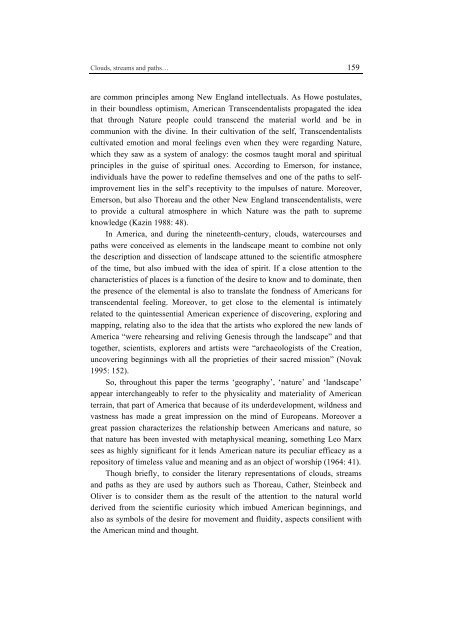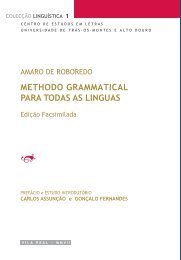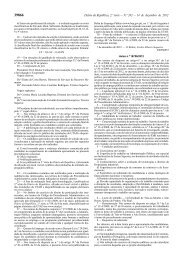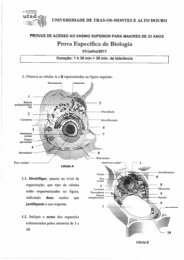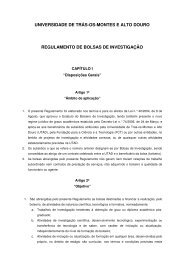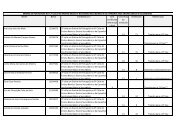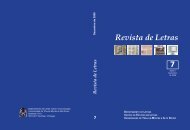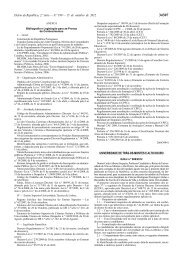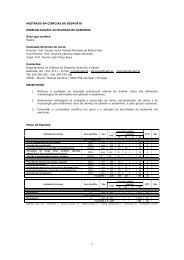- Page 1 and 2:
Dezembro de 2010Revista de LetrasRe
- Page 4:
Cartas do meu rio, Douro, nas comem
- Page 7 and 8:
ÍNDICENota IntrodutóriaCarlos Ass
- Page 9:
Cartas do meu rio, Douro, nas comem
- Page 12 and 13:
8 Nota IntrodutóriaA atenção à
- Page 15:
LINGUÍSTICA
- Page 18 and 19:
14 António Bárbolo Alves, Margari
- Page 20 and 21:
16 António Bárbolo Alves, Margari
- Page 22 and 23:
18 António Bárbolo Alves, Margari
- Page 24:
20 António Bárbolo Alves, Margari
- Page 29 and 30:
Yerbas i árboles de la Tierra de M
- Page 31 and 32:
Yerbas i árboles de la Tierra de M
- Page 33 and 34:
Yerbas i árboles de la Tierra de M
- Page 35 and 36:
Yerbas i árboles de la Tierra de M
- Page 37 and 38:
Yerbas i árboles de la Tierra de M
- Page 39:
Yerbas i árboles de la Tierra de M
- Page 42 and 43:
38 Sónia Coelhoposterioridade, tod
- Page 44 and 45:
40 Sónia Coelhopertence a todos os
- Page 46 and 47:
42 Sónia Coelho2.3. Aumentativos2.
- Page 48 and 49:
44 Sónia CoelhoPara a língua port
- Page 50 and 51:
46 Sónia Coelhoproposições de, o
- Page 52 and 53:
48 Sónia CoelhoSchäfer-Prieß, Ba
- Page 54 and 55:
50 Rui Dias GuimarãesIntroduçãoA
- Page 56 and 57:
52 Rui Dias GuimarãesMapa dos Dial
- Page 58 and 59:
54 Rui Dias GuimarãesNas recolhas
- Page 60 and 61:
56 Rui Dias Guimarãescomo sua esta
- Page 62 and 63:
58 Rui Dias Guimarãesuma serpente
- Page 64 and 65:
60 Rui Dias GuimarãesInfluence on
- Page 67 and 68:
O ideário linguístico no Novo met
- Page 69 and 70:
O ideário linguístico no Novo met
- Page 71 and 72:
O ideário linguístico no Novo met
- Page 73 and 74:
O ideário linguístico no Novo met
- Page 75 and 76:
O ideário linguístico no Novo met
- Page 77 and 78:
O ideário linguístico no Novo met
- Page 79 and 80:
O ideário linguístico no Novo met
- Page 81 and 82:
O ideário linguístico no Novo met
- Page 83 and 84:
O ideário linguístico no Novo met
- Page 85 and 86:
O ideário linguístico no Novo met
- Page 87 and 88:
O ideário linguístico no Novo met
- Page 89 and 90:
O ideário linguístico no Novo met
- Page 91 and 92:
O ideário linguístico no Novo met
- Page 93 and 94:
O ideário linguístico no Novo met
- Page 95 and 96:
O ideário linguístico no Novo met
- Page 97 and 98:
Contributos para a análise da elip
- Page 99 and 100:
Contributos para a análise da elip
- Page 101 and 102:
Contributos para a análise da elip
- Page 103 and 104:
Contributos para a análise da elip
- Page 105 and 106:
Contributos para a análise da elip
- Page 107:
Contributos para a análise da elip
- Page 110 and 111:
106 Maria Olinda Rodrigues Santanae
- Page 112 and 113: 108 Maria Olinda Rodrigues SantanaL
- Page 114 and 115: 110 Maria Olinda Rodrigues SantanaL
- Page 116 and 117: 112 Maria Olinda Rodrigues Santanac
- Page 118 and 119: 114 Maria Olinda Rodrigues Santanaa
- Page 120 and 121: 116 Maria Olinda Rodrigues SantanaS
- Page 122 and 123: 118 Maria Olinda Rodrigues SantanaR
- Page 124 and 125: 120 Maria Olinda Rodrigues SantanaA
- Page 126 and 127: 122 Barbara Schäfer-Prießservem c
- Page 128 and 129: 124 Barbara Schäfer-PrießFinalmen
- Page 130 and 131: 126 Barbara Schäfer-Prieß1.2 A Ar
- Page 132 and 133: 128 Barbara Schäfer-Prießcomprovo
- Page 134 and 135: 130 Barbara Schäfer-Prießa pergun
- Page 136 and 137: 132 Barbara Schäfer-PrießDe manei
- Page 138 and 139: 134 Barbara Schäfer-Prieß[...] qu
- Page 140 and 141: 136 Barbara Schäfer-Prieß2.1.4. C
- Page 142 and 143: 138 Barbara Schäfer-PrießComo fut
- Page 144 and 145: 140 Barbara Schäfer-PrießLusitani
- Page 146 and 147: 142 Barbara Schäfer-Prieß(iuncta
- Page 148 and 149: 144 Barbara Schäfer-Prieß2.2.4. C
- Page 150 and 151: 146 Barbara Schäfer-Prießpræsens
- Page 152 and 153: 148 Barbara Schäfer-Prießprimeira
- Page 154 and 155: 150 Barbara Schäfer-PrießCunha (1
- Page 156 and 157: 152 Barbara Schäfer-PrießPonce de
- Page 159: LITERATURA
- Page 164 and 165: 160 Isabel Maria Fernandes AlvesTho
- Page 166 and 167: 162 Isabel Maria Fernandes Alveson
- Page 168 and 169: 164 Isabel Maria Fernandes Alveswil
- Page 170 and 171: 166 Isabel Maria Fernandes AlvesOli
- Page 172 and 173: 168 Laura Alves e Armindo MesquitaB
- Page 174 and 175: 170 Laura Alves e Armindo Mesquitao
- Page 176 and 177: 172 Laura Alves e Armindo MesquitaS
- Page 178 and 179: 174 Laura Alves e Armindo Mesquita
- Page 181 and 182: La comparaison de L’Âne de Lucie
- Page 183 and 184: La comparaison de L’Âne de Lucie
- Page 185 and 186: La comparaison de L’Âne de Lucie
- Page 187 and 188: La comparaison de L’Âne de Lucie
- Page 189: La comparaison de L’Âne de Lucie
- Page 192 and 193: 188 Cesarina Donativerdadeira «per
- Page 194 and 195: 190 Cesarina Donatile refus du temp
- Page 196 and 197: 192 Cesarina Donatiil tempo, ma cer
- Page 198 and 199: 194 Cesarina Donatigeneralmente vis
- Page 200 and 201: 196 Cesarina DonatiProfondamente an
- Page 202 and 203: 198 Cesarina Donatimodo la sua imma
- Page 204 and 205: 200 Cesarina DonatiPara eles, o gen
- Page 206 and 207: 202 Cesarina DonatiNella dimora ago
- Page 209 and 210: Quando a História oficial se encon
- Page 211 and 212: Quando a História oficial se encon
- Page 213 and 214:
Quando a História oficial se encon
- Page 215 and 216:
Quando a História oficial se encon
- Page 217 and 218:
Quando a História oficial se encon
- Page 219 and 220:
Quando a História oficial se encon
- Page 221 and 222:
Quando a História oficial se encon
- Page 223:
Quando a História oficial se encon
- Page 226 and 227:
222 Maria Luísa de Castro SoaresEn
- Page 228 and 229:
224 Maria Luísa de Castro Soaresqu
- Page 230 and 231:
226 Maria Luísa de Castro Soareses
- Page 232 and 233:
228 Maria Luísa de Castro SoaresSe
- Page 234 and 235:
230 Maria Luísa de Castro SoaresA
- Page 236 and 237:
232 Maria Luísa de Castro SoaresCo
- Page 239:
CULTURA
- Page 242 and 243:
238 Natália Fauvrelle1. Principais
- Page 244 and 245:
240 Natália FauvrelleProduziu-se e
- Page 246 and 247:
242 Natália FauvrelleDouro, Casa d
- Page 248 and 249:
244 Natália Fauvrellesujeito a est
- Page 250 and 251:
246 Natália Fauvrellepaisagística
- Page 252 and 253:
248 Natália FauvrelleO modelo de f
- Page 254 and 255:
250 Natália Fauvrellefundamental i
- Page 256 and 257:
252 Carla Sofia Gomes Xavier Luís
- Page 258 and 259:
254 Carla Sofia Gomes Xavier Luís
- Page 260 and 261:
256 Carla Sofia Gomes Xavier Luís
- Page 262 and 263:
258 Carla Sofia Gomes Xavier Luís
- Page 264 and 265:
260 Carla Sofia Gomes Xavier Luís
- Page 266 and 267:
262 Carla Sofia Gomes Xavier Luís
- Page 269 and 270:
Vertentes do Douro, Uma Voz do Dour
- Page 271 and 272:
Vertentes do Douro, Uma Voz do Dour
- Page 273:
Vertentes do Douro, Uma Voz do Dour
- Page 276 and 277:
272 M.ª Manuel da Silva Nascimento
- Page 278 and 279:
274 M.ª Manuel da Silva Nascimento
- Page 280 and 281:
276 M.ª Manuel da Silva Nascimento
- Page 282 and 283:
278 M.ª Manuel da Silva Nascimento
- Page 284 and 285:
280 M.ª Manuel da Silva Nascimento
- Page 286 and 287:
282 M.ª Manuel da Silva Nascimento
- Page 289 and 290:
Caminhos-de-ferro em Trás-os-Monte
- Page 291 and 292:
Caminhos-de-ferro em Trás-os-Monte
- Page 293 and 294:
Caminhos-de-ferro em Trás-os-Monte
- Page 295 and 296:
Caminhos-de-ferro em Trás-os-Monte
- Page 297 and 298:
Caminhos-de-ferro em Trás-os-Monte
- Page 299 and 300:
Caminhos-de-ferro em Trás-os-Monte
- Page 301 and 302:
Caminhos-de-ferro em Trás-os-Monte
- Page 303 and 304:
Caminhos-de-ferro em Trás-os-Monte
- Page 305 and 306:
Caminhos-de-ferro em Trás-os-Monte
- Page 307 and 308:
Caminhos-de-ferro em Trás-os-Monte
- Page 309 and 310:
A Cultura Duriense na Poesia de Ant
- Page 311 and 312:
A Cultura Duriense na Poesia de Ant
- Page 313 and 314:
A Cultura Duriense na Poesia de Ant
- Page 315 and 316:
A Cultura Duriense na Poesia de Ant
- Page 317 and 318:
A História n’ “A Inaudita Guer
- Page 319 and 320:
A História n’ “A Inaudita Guer
- Page 321 and 322:
A História n’ “A Inaudita Guer
- Page 323 and 324:
A História n’ “A Inaudita Guer
- Page 325 and 326:
A História n’ “A Inaudita Guer
- Page 327 and 328:
A História n’ “A Inaudita Guer
- Page 329 and 330:
A História n’ “A Inaudita Guer
- Page 331 and 332:
A História n’ “A Inaudita Guer
- Page 333:
A História n’ “A Inaudita Guer
- Page 337 and 338:
As Gazetas: o nascimento do jornali
- Page 339 and 340:
As Gazetas: o nascimento do jornali
- Page 341 and 342:
As Gazetas: o nascimento do jornali
- Page 343 and 344:
As Gazetas: o nascimento do jornali
- Page 345 and 346:
As Gazetas: o nascimento do jornali
- Page 347 and 348:
As Gazetas: o nascimento do jornali
- Page 349:
As Gazetas: o nascimento do jornali
- Page 352 and 353:
348 Marlene Loureiroentendida como
- Page 354 and 355:
350 Marlene Loureiro2. O géneroO g
- Page 356 and 357:
352 Marlene Loureiroaquilo que Goff
- Page 358 and 359:
354 Marlene Loureiro(2006) justifiq
- Page 360 and 361:
356 Marlene Loureiro4. ConclusõesE
- Page 362 and 363:
358 Marlene LoureiroMills, Sara (20
- Page 364 and 365:
360 J. Esteves ReiMas a Carta é, a
- Page 366 and 367:
362 J. Esteves ReiVila Real; mas ta
- Page 368 and 369:
364 J. Esteves ReiSem actividade cr
- Page 370 and 371:
366 J. Esteves ReiHá muitos anos,
- Page 372 and 373:
368 J. Esteves Reique, entre 1907 e
- Page 374 and 375:
370 J. Esteves ReiFrancisco José C
- Page 376 and 377:
372 J. Esteves ReiO que pretendemos
- Page 378 and 379:
374 J. Esteves ReiFazei, por tanto,
- Page 380 and 381:
376 J. Esteves Rei2013, destinados
- Page 382 and 383:
378 J. Esteves ReiMas, ao distingui
- Page 385 and 386:
A recepção do Douro no Jornal O P
- Page 387 and 388:
A recepção do Douro no Jornal O P
- Page 389 and 390:
A recepção do Douro no Jornal O P
- Page 391 and 392:
A recepção do Douro no Jornal O P
- Page 393 and 394:
A recepção do Douro no Jornal O P
- Page 395 and 396:
A recepção do Douro no Jornal O P
- Page 397 and 398:
A recepção do Douro no Jornal O P
- Page 399:
DIDÁTICA DAS LÍNGUAS
- Page 402 and 403:
398 Maria da Graça Sardinha e Ant
- Page 404 and 405:
400 Maria da Graça Sardinha e Ant
- Page 406 and 407:
402 Maria da Graça Sardinha e Ant
- Page 409 and 410:
Escola e Leitura: transversalidade
- Page 411 and 412:
Escola e Leitura: transversalidade
- Page 413 and 414:
Escola e Leitura: transversalidade
- Page 415 and 416:
Escola e Leitura: transversalidade
- Page 417:
VARIA
- Page 420 and 421:
416 Henriqueta Maria GonçalvesJos
- Page 422 and 423:
418 Henriqueta Maria GonçalvesRegi
- Page 424 and 425:
420 Henriqueta Maria Gonçalvesà h
- Page 427 and 428:
RECENSÃORuivo-Tomate de Rita Pinho
- Page 429 and 430:
Recensão: Ruivo-Tomate de Rita Pin
- Page 431 and 432:
Recensão: Ruivo-Tomate de Rita Pin
- Page 433 and 434:
Recensão: Ruivo-Tomate de Rita Pin
- Page 435 and 436:
Recensão: Ruivo-Tomate de Rita Pin


